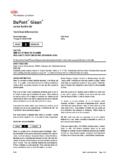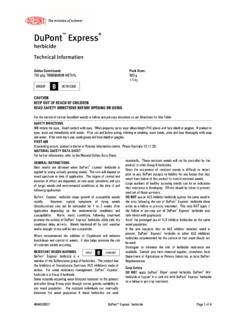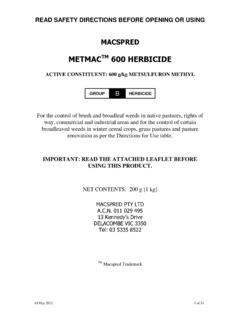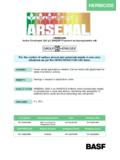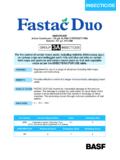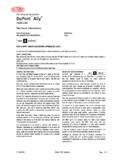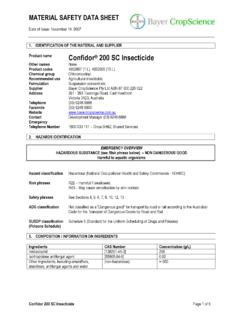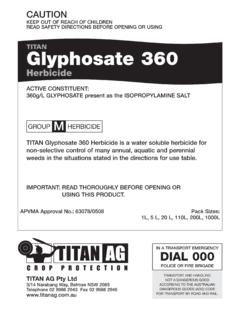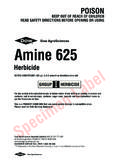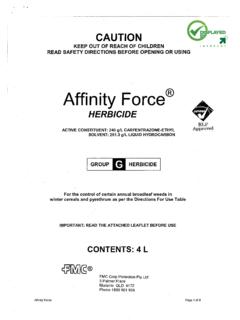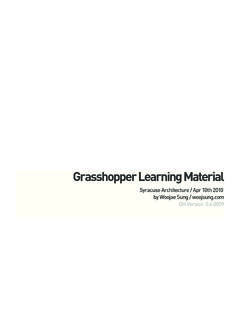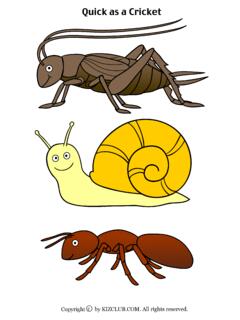Transcription of KEEP OUT OF REACH OF CHILDREN READ SAFETY …
1 03/2004 rhino Page 1 of 3 CROP/SITUATIONWEEDRATE L/ha WHPSTATESWEEDSTAGECRITICAL COMMENTSW heat, linseed,triticale, canola(rapeseed),safflower, rye,barleyLupins, peasWheat, linseed,triticale, safflower,rye, barley, canola(rapeseed)Lupins, peasPasture legumeseed cropsOilseed poppies2 to 4 leaf2 to 4 leaf2 to 4 leafSee CriticalComments2 to 3 leaf3 to 4 leafAll StatesNSW onlyNSW, Vic,Tas, SA,WA onlyNSW onlyAll StatesAll StatesTas onlyNSW, Vic,Tas, SA,WA (notbarley)Apply generally 3 to 6 weeks after sowing, whencereals usually 2 to 5 leaves. For barley, applyonly when crop is 4 to 5 leaf stage. Add wettingagent at to water in spray tank ie. 250 mL Wetspray 1000/100 L water. This isirrespective of volume of water/ha or rate ofRHINO. DO NOT add wetting agent if mixing withsome other sprays (refer compatibility).For barley, apply only when crop is 4 to 5 leaf double spraying (overlap) at the maximumrate of L/ha.
2 In crops other than barley, use 2 Lrate if most weeds 3 to 4 leaf and if spraying 4 to 6weeks after sowing, especially in northern NSWand Qld. Add wetting agent as above. Use L rateonly if growing conditions are very favourable andweeds are 2 to 3 leaf, 3 to 4 weeks after sowing, andcereals usually 2 to 3 wetting agent as above. Ensure thoroughcoverage of NOT add wetting agent. Apply in accordancewith recommendations made by the Departmentof Agriculture or the poppy contracting Ryegrass(Wimmera)Common BarbgrassAnnual RyegrassCommon barbgrassWild OatsWild OatsWild OatsWild Oats, AnnualRyegrass (refer criticalcomments)Annual Ryegrass2 to 3 leaf3 to 4 to to 32 For the post emergent control of annual ryegrass, common barbgrass andwild oats in wheat, linseed, peas, crowsfoot grass (Eleusine indica) in turfspecies and other crops as specified in the Directions for CONSTITUENT:375 g/L DICLOFOP-METHYLSOLVENT:534 g/L HYDROCARBON LIQUIDR hino POISONKEEP OUT OF REACH OF CHILDRENREAD SAFETY DIRECTIONS BEFORE OPENING OR HERBICIDEDIRECTIONS FOR USERESTRAINTS:DO NOT apply to weeds or turf under stress due to, for example, very dry, very wet, nutrient deficient, frosty ordiseased conditions.
3 DO NOT apply if rain is expected within 2 hours. DO NOT spray when temperatures are higher than NOT use on rye-grass turf. rhino Page 2 of 3 NOT TO BE USED FOR ANY PURPOSE, OR IN ANY MANNER, CONTRARY TO THIS LABEL UNLESS AUTHORISED UNDER PERIOD (WHP): ALL CROPS: DO NOT GRAZE OR CUT FOR STOCKFEED FOR 7 WEEKS AFTER : DO NOT ALLOW TREATED AREAS OR CLIPPINGS TO BE GRAZED BY OR FED TO L/ha WHPSTATESWEEDSTAGECRITICAL COMMENTSTurf:kikuyu, hibrid couchcv. TifdwardSee CriticalCommentsQld, NSW,ACT only1 L/ha or100 mL in100 L ofwater per1000 m2 Apply to weeds between the seedling andtillering stage for best results. Use lower rates forseedlings and higher rates for established grassweeds. A repeat spray may be needed in 2 to 4weeks. Results are best when rhino is applied undergood growing conditions and weeds havesufficient leaf area ie.
4 2 to 3 days after mowing. Crowsfoot Grass(Eleusine indica)Queensland bluecouch1 to or100 to 150mL in 100L ofwater per1000 m2 Common couch,Buffalo, hybridcouch cv. Tifway,carpet grass, salt couch1 to or100 to 250mL in 100L ofwater per1000 m2 rhino Page 3 of 3 GENERAL INSTRUCTIONSR esults are best under good growing conditions and application toweeds or crop under stress (eg. due to continuous severe frosts, dry orwaterlogged conditions) should be avoided. Wild Oats germinatingafter application will often be stunted and will not seriously competewith the crop. Application to crops with a covering of frost or dew hasbeen successful but should be avoided if spraying cannot becompleted. However, it is not recommended that this be spraying cannot be completed spray mixtures of rhino in cleanwatermay be left overnight without significant loss of efficacy.
5 Themixture should be well agitated before spraying re-commences. It isnot recommendedthat this be general WEEDS WARNINGFARMOZ rhino Selective Herbicide is amember of the aryloxyphenoxypropionategroup of herbicides. rhino has the inhibition of acetyl coAcarboxylase mode of action. For weed resistance management RHINOis a Group A herbicide. Some naturally-occurring weed biotypesresistant to rhino and other Group A herbicides may exist throughnormal genetic variability in any weed population. The resistantindividuals can eventually dominate the weed population if theseherbicides are used repeatedly. These resistant weeds will not becontrolled by rhino or other Group A herbicides. Since occurrence ofresistant weeds is difficult to detect prior to use, FARMOZ Pty.
6 No liability for any losses that may result from the failure ofRHINO to control resistant to apply rhino to base of weeds and ensure the required quantity of rhino directly to the spray tank whenabout two-thirds full. Top up with water to required volume, withagitators in motion. Where wetting agents are recommended, add justbefore tank is full of water to avoid excessive Sprayers: standard boom sprays only are recommended andmust be fitted with by-pass or mechanical agitation. It is recommendedto use approximately 50 to 150 L water/ha and a droplet size of 200 to300 microns. DO NOT apply with boomless jets or : Best results have been obtained using 20 to 30 L water/hawith a steady cross wind and a swath width of 15 to 18 metres. Aim fora droplet size of 200 to 300 microns.
7 DO NOT exaggerate swath operators should consult manufacturer for For broadleaf weed control in wheat, barley, triticale and rye, thefollowing compatibilities are indicated. rhino may be mixed withthe following products without a significant loss of activity:Bromoxynil, Lontrel* (up to 150 mL/ha), dimethoate, omethoate andphosmet. rhino may be mixed with the following products, but someloss of grass weed control and/or speed of kill should be expected:Bromoxynil + MCPA, Tigrex* (max. 800 mL/ha), MCPA LVE (max. 700mL/ha). rhino may be mixed with the following products, but someloss of wild oat control should be expected: Jaguar* (up to 750mL/ha), Eclipse* (up to 7 g/ha). rhino may be tank mixed withBroadstrike* (up to 25 g/ha) where control of wild oats is When mixing with broadleaf herbicides add Wetspray 1000surfactant at the rate of 250 mL per 100 L of spray in grass weed control (as indicated above)can beminimised by using a minimum of 80L water per ha by ground and 30L by air, and if wild oats are present, use L rhino /ha (exceptbarley).
8 DO NOT use Bromoxynil + MCPA at rates above L/hawhen mixing with rhino and FARMOZ Lynx are physically compatible but when thismixture is used a significant reduction in grass weed control can beexpected. Add wetting agent to this mixture as for rhino atrecommended rates. Consult company representatives for Allow at least 10 days between any application of rhino and otherherbicides containing 2, 4-D, MCPA, dicamba or other similar sprays,which should preferably follow For use in oilseed poppies in Tasmania only: rhino may be mixedwith pesticides as recommended by the Department of Agricultureor the poppy contracting Where phalaris is present, rhino and Puma* S may be appliedtogether at the respective recommended rates. Wetting agentshould be added to this mixture at the rate recommended on theRHINO OF WILDLIFE, FISH, CRUSTACEANS ANDENVIRONMENTDO NOT contaminate streams, rivers or waterways with this product orthe used OF CROP, NATIVE AND OTHER NON-TARGET PLANTSDO NOT apply under weather conditions or from spraying equipmentwhich could be expected to cause spray to drift onto nearbysusceptible plants, crops, cropping lands (eg.)
9 Maize, sorghum, rice) orpastures. DO NOT plant susceptible crops ( maize, sorghum, rice)for 10 weeks after clovers and medics rhino does not affect undersownclovers or medics or other broadleaf crops, and has no activity againstbroadleaf AND DISPOSALS tore in the closed, original container in a cool, well-ventilated NOT store for prolonged periods in direct sunlight. Triple orpreferably pressure rinse containers before disposal. Add rinsings tospray tank. DO NOT dispose of undiluted chemicals on-site. Ifrecycling, replace cap and return clean containers to recycler ordesignated collection point. If not recycling, break, crush or punctureand bury empty containers in a local authority landfill. If no landfill isavailable, bury the containers below 500 mm in a disposal pitspecifically marked and set up for this purpose clear of waterways,desirable vegetation and tree roots.
10 Empty containers and productshould not be DIRECTIONSWill irritate the eyes and skin. Avoid contact with eyes and skin. DONOT inhale vapour. When opening the container, preparing spray andusing the prepared spray, wear cotton overalls buttoned to the neckand wrist, and washable hat, elbow-length PVC gloves and goggles. Ifproduct in eyes, wash it out immediately with water. After use andbefore eating, drinking or smoking, wash hands, arms and facethoroughly with soap and water. After each day s use, wash gloves,goggles and contaminated clothing. FIRST AIDIf poisoning occurs, contact a doctor or Poisons Information Centre on131126. MSDSA dditional information is listed in the material SAFETY data sheet(MSDS). A material SAFETY data sheet for rhino is available fromFARMOZ on request.
